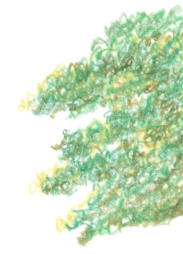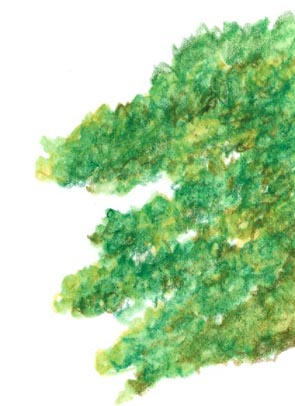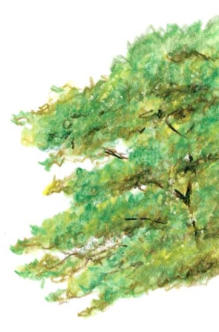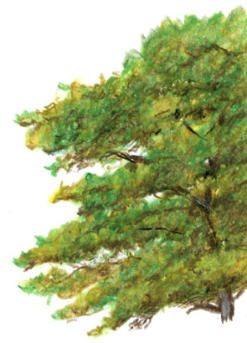- Home
- Beyond Basics
- Watercolour pencils
- Draw trees
How to Draw Realistic Trees That Don't Look Like Green Blobs
You know that sinking feeling when you're working on what should be a beautiful landscape, and it's time to add the trees?
You've got the composition planned, the basic shapes sketched out, but the moment you start drawing foliage, everything falls apart.
Instead of the majestic oak or graceful birch you're envisioning, you end up with what looks like a green blob on a stick. Or worse - a child's lollipop tree that screams "amateur" no matter how much detail you try to add.
I used to avoid drawing trees altogether. My landscapes looked empty and lifeless, but I convinced myself they were "minimalist."
The truth?
I was terrified of ruining a good drawing with trees that looked like they belonged in a cartoon rather than nature.
But here's what changed everything: Trees aren't about drawing individual leaves.
They're about understanding structure, light, and the way foliage actually grows.
Once you grasp these fundamentals, you can create convincing trees that add life and depth to any landscape—whether you're drawing the ancient oaks of the New Forest or the pine forests dotting Scottish hillsides.
In this guide, I'll show you my systematic approach to drawing trees that look three-dimensional and realistic.
You'll learn how to capture the essence of different tree types without getting lost in overwhelming detail, and how to use watercolour pencils to create the rich textures and subtle colour variations that make trees come alive on paper.
Most importantly, you'll discover why "messy" technique often produces the most convincing results—and how to control that messiness for maximum realism.
If you find yourself guessing at tree shapes rather than seeing them clearly, strengthen your observation skills first—it'll make everything else click into place.
What Kind of Tree Drawing Approach Do You Need?
Before we dive into technique, let's make sure you're using the right approach for your goals and the trees you want to capture.
Use This Watercolour Pencil Technique When You Want To
- Create realistic foliage texture without drawing individual leaves
- Capture the play of light and shadow through tree canopies
- Add convincing trees to landscapes that enhance rather than distract
- Work efficiently with a technique that builds up gradually
- Handle complex tree shapes like mature oaks, dense hedgerows, or mixed woodland
- Create depth and atmosphere in outdoor scenes
Perfect for: UK landscape scenes, garden studies, countryside views, any drawing where trees play a supporting or starring role.
When This Approach May Not Be Right
- Botanical illustration where individual leaf accuracy matters
- Architectural drawings where trees are simple background elements
- Quick gesture sketches where speed matters more than realism
- Highly stylized or graphic work where naturalistic texture isn't the goal
The Reality About Drawing Trees
Many artists avoid trees because they think they need to draw every leaf. That's like thinking you need to paint every grass blade in a meadow.
The secret is learning to suggest detail convincingly—and that's exactly what this technique does.
However, this method requires patience.
You'll build up layers gradually, and the tree won't look "right" until the final stages. Trust the process, even when early stages look messy or incomplete.
What Trees Should UK Artists Know How to Draw?
Let's talk about the trees you're most likely to encounter in British landscapes—and how their characteristics affect your drawing approach.
Common UK Trees and Their Drawing Challenges
English Oak (Quercus robur)
- Characteristics: Broad, rounded crown with dense, clustered foliage
- Drawing challenge: Complex overlapping leaf masses
- Key technique: Focus on major foliage clumps, not individual branches
Silver Birch (Betula pendula)
- Characteristics: Delicate, drooping branches with light, airy foliage
- Drawing challenge: Maintaining lightness while showing structure
- Key technique: Leave plenty of sky gaps, use lighter pressure
Scots Pine (Pinus sylvestris)
- Characteristics: Irregular crown, needle clusters, distinctive bark
- Drawing challenge: Needle texture without overworking
- Key technique: Suggest needle masses with directional strokes
Beech (Fagus sylvatica)
- Characteristics: Smooth, dense canopy in summer; beautiful autumn colours
- Drawing challenge: Avoiding the "green blob" effect
- Key technique: Strong light/shadow contrast to show form
What Supplies Work Best for UK Artists Drawing Trees?
Watercolour Pencils That Handle UK Subjects Well
Derwent Watercolour Pencils
Where to buy: Hobbycraft, local art shops across the UK
Price range: £12-115 for sets
Why I recommend them: Excellent for UK outdoor work, respond well to British weather conditions
Best colors for trees: Sap Green, Yellow Ochre, Burnt Sienna, Raw Umber
Faber-Castell Albrecht Dürer
Where to buy: Jackson's Art Supplies, Amazon UK
Price range: £35-150 for sets
Why I use them: Excellent lightfastness for finished work, rich color mixing
Best for: Detailed tree studies, work you want to last
Paper That Works in British Conditions
- Bockingford watercolour paper - British-made, handles moisture well
- Langton watercolour paper - Budget-friendly, good for practice
- Arches watercolour paper - Premium option for finished work
Useful Colours for UK Tree Drawing
You don't need dozens of greens. These six colours will handle most British trees:
- Sap Green - Your base green for most foliage
- Yellow Ochre - Warm highlights, autumn colours
- Raw Sienna - Tree trunks, branches, earth tones
- Burnt Sienna - Darker branches, autumn colours
- Ultramarine Blue - Cool shadows, distant trees
- Cadmium Yellow - Bright highlights, spring green mixes
How Do You Draw Trees That Look Three-Dimensional?
Here's my step-by-step method that works whether you're drawing a single specimen tree or a woodland scene:
Step 1: Understand Your Tree's Structure
Before touching pencil to paper, study your reference (or the tree itself if working outdoors):
- Overall shape: Is it tall and narrow, broad and spreading, or something between?
- Main foliage masses: Trees have 3-5 major clumps of leaves, not one big blob
- Light direction: Which sides are lit, which are in shadow?
- Sky holes: Where does sky show through? These are crucial for realism
Step 2: Sketch the Basic Structure
Using a light pencil, map out:
- The trunk and main branches (very simplified)
- The overall outline of each major foliage mass
- Where the largest sky gaps will be
- Don't draw details yet—just the basic architecture
Step 3: Block in the Light and Dark Pattern
This is where watercolour pencils excel:
- Choose your base green (Sap Green works well)
- Using loose, scribbly strokes, fill in the shadow sides of each foliage mass
- Leave the light-struck areas as paper for now
- Don't worry about leaf texture—focus on getting the big light/dark pattern right
- Keep your strokes loose and varied in direction

Step 4: Add Your First Water Layer
Here's where the magic happens:
- Using a clean, slightly damp brush, gently work over your pencil marks
- Don't saturate the paper—just enough water to move the pigment
- Let the colors blend naturally, but maintain your light/dark pattern
- Work in sections so you can control the wetness
- Allow to dry completely before the next step

Step 5: Build Up Colour Complexity
Now we add the subtle variations that make trees look real:
- Add warmer greens (Yellow Ochre mixed with your base green) to light-struck areas
- Add cooler colours (Ultramarine + green) to deeper shadows
- Use different greens to suggest different leaf densities
- Work dry over your previous wet layer for texture
Step 6: Define the Branch Structure
This step brings everything together:
- Using Raw Sienna or Burnt Sienna, sketch in the main branches
- Don't draw continuous lines—let branches disappear behind foliage
- Some branches cross sky gaps, others don't
- Vary the branch thickness logically (thicker near trunk, thinner at ends)

Step 7: Final Water Pass and Detail
The finishing touches:
- Another light water pass to integrate colours
- Add small branches and twigs with dry pencil
- Refine sky gaps—they should vary in size and shape
- Add any final colour notes or texture details

What Are the Key Points to Remember?
- Work general to specific - Big shapes first, details last
- Sky gaps are essential - No tree is a solid mass
- Light direction matters - Consistent lighting makes trees believable
- Branches have logic - They get thinner as they extend outward
- Texture comes from variation - Don't make all areas equally detailed
Why Do My Trees Still Look Like Green Blobs
Problem 1: No Clear Light/Dark Pattern
- Signs: Your tree looks flat, like a cutout pasted on the paper
- Cause: You're coloring everything equally instead of following the light
- Solution: Squint at your reference—you should see clear light and dark shapes. Ignore leaf details and follow these big patterns
Problem 2: Not Enough Sky Gaps
- Signs: Tree looks solid and heavy, lacks airiness
- Cause: Fear of "breaking up" the tree shape
- Solution: Real trees have lots of gaps. Look at any tree outside—you'll see sky through it in multiple places
Problem 3: Overthinking Individual Leaves
Signs: Getting bogged down in tiny details early on
Cause: Trying to draw what you know rather than what you see
Solution: Stand back from your reference. Trees are about mass and texture, not individual leaves
Problem 4: Inconsistent Branch Logic
Signs: Branches that don't make structural sense
Cause: Adding branches as decoration rather than structure
Solution: Follow the tree's actual architecture. Branches should connect logically and get thinner as they extend out from the centre
How Do I Handle Specific Tree-Drawing Challenges?
"My foliage looks too uniform and artificial"
- Vary your pencil pressure within each area
- Change stroke direction frequently
- Use multiple shades of green, even in small areas
- Leave some areas less finished than others
"I can't get the texture right with watercolour pencils"
- Work in layers: wet, dry, wet, dry
- Don't dissolve all the pencil marks—leave some texture
- Try working on slightly textured paper for more interesting effects
- Use the dry pencil over wet areas for broken, realistic texture
"My trees always look too dark and heavy"
- You may be starting too dark—begin lighter than you think you need
- Check your light source—are you showing enough light-struck areas?
- Consider the tree's environment—distant trees are lighter and cooler
- Don't forget reflected light in shadow areas
"I can't make different tree species look distinct"
- Focus on overall shape first—oak vs. birch have very different silhouette
- Study branch patterns—some droop, others reach upward
- Leaf density varies—some trees are denser, others more open
- Color temperature differs—some species have warmer or cooler greens
What Should I Do When Working Outdoors in the UK
Dealing with British Weather
- Carry a small umbrella or work under shelter when possible
- Watercolour pencils are more forgiving than pure watercolors in light rain
- Work faster on overcast days—the light stays more consistent
- Take photos for color reference in case weather changes
Choosing the Right Time
- Early morning and late afternoon provide the best light direction
- Overcast days give softer, easier lighting for beginners
- Avoid midday sun—it creates harsh, confusing shadows
- Spring and autumn offer the most interesting tree colors
What Should You Practice After Learning This Tree Technique?
Tree drawing is just one piece of creating convincing landscapes. Here's how this skill connects to other essential techniques:
Which Skills Support Better Tree Drawing?
- Master basic form and structure
- Study light and shadow - Trees are all about light patterns
- Learn atmospheric perspective
Where Can You Apply This Tree Technique?
- Landscape composition - Trees as focal points and supporting elements
- Drawing water reflections - Trees often reflect in lakes and rivers
- Sky and cloud studies - Trees interact with sky in important ways
What Tree Should You Draw First?
Start with a simple, well-lit tree that you can observe directly—either outdoors or from a window. Choose something with a clear, recognizable shape like a mature oak or a silver birch. Avoid complex woodland scenes until you've mastered single trees.
Set yourself up for success: good lighting, comfortable position, and no time pressure. This technique requires patience, but the results are worth it.
Having Trouble with Specific Tree Types?
Every tree species has its quirks, and British trees can be particularly challenging because of their complex, irregular growth patterns.
If you're struggling with a specific type—whether it's getting the delicate structure of a birch or the massive presence of an ancient oak—I'd love to help.
Remember: every convincing tree drawing you've admired was built up gradually, just like you're learning to do. The patience you invest in understanding this systematic approach will serve you in every landscape you create going forward.
Ready to Add Trees to Your Landscapes?
Trees transform landscapes from empty spaces into living environments. Once you've mastered this technique, you'll find yourself seeing trees differently—noticing their structure, their light patterns, their individual character.
The next time you're outdoors, take a moment to really observe the trees around you. See how many sky gaps you can count in a single tree. Notice how the light strikes different parts of the canopy. This observation is just as important as the technical skill—and it's what separates convincing tree drawings from generic green shapes.
Improve Your Pencil Art: Get Free Tips & Techniques
Sign up for our newsletter – just occasional emails packed with practical advice and inspiration for pencil artists like yourself








